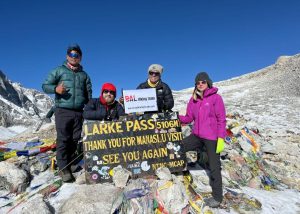- balhikingteam@gmail.com
- WhatsApp: +9779823697496
Here in Nepal the two “gold‑standard” trekking windows are spring (March–May) and autumn (late September–November). Below is a breakdown of each season, plus a quick look at monsoon and winter trekking for those with more flexibility: Bal Hiking Team suggest Best Trekking Season in Nepal as below:-

Weather: Stable, mostly clear skies; daytime highs 15–20 °C at 3,000 m, cooler nights.
Highlights: Rhododendron forests explode in bloom (especially in the Annapurna and Langtang regions); excellent mountain views; warming trails after winter.
Crowds & Permits: Peak time—teahouses fill up quickly, so book a few days ahead if possible.
Best for: Anyone seeking mild weather, wildflowers, and clear vistas.
Weather: Crystal‑clear skies after the monsoon; daytime highs 10–18 °C at 3,000 m; chilly at night but no snow at lower passes.
Highlights: Lush, rain‑washed valleys; festivals such as Dashain (usually October) and Tihar (October/November) in Kathmandu and Pokhara; spectacular sunrise views.
Crowds & Permits: Also very busy—especially October. Book teahouses and permits early.
Best for: Photographers, festival‑seekers, first‑time trekkers who want unbeatable views.
Weather: Daily rains (often heavy), slippery trails, frequent clouds obstruct mountain panoramas.
Highlights: Verdant lowland jungles in the Terai (Chitwan, Bardia) and lower‑elevation treks (e.g. Tsum Valley, Kanchenjunga Base Camp) can be surprisingly beautiful.
Drawbacks: Landslide risk, leeches, washed‑out bridges.
Best for: Very experienced, well‑equipped trekkers who want solitude and don’t mind rain.
Weather: Cold—sub‑zero nights above 3,000 m, daytime 5–10 °C; snow on high passes.
Highlights: Crystal‑clear air; off‑season rates; uncrowded teahouses.
Drawbacks: Many high‑pass routes (e.g. Thorong La, Cho La) are closed or dangerous.
Best for: Lower‑elevation treks (Poon Hill, Ghorepani, Tamang Heritage Trail) or those with cold‑weather gear and high‑altitude experience.
High Himalaya (e.g. Everest, Annapurna Circuit): Aim for spring or autumn only.
Mid‑Hills (Langtang, Helambu, Manaslu Base Camp): Spring/Autumn optimal; winter possible with heavy gear.
Low‑Elevation Routes (Terai, short valley walks): Year‑round, but avoid monsoon if you dislike heavy rain.
Permits: TIMS card + national‑park permits can be arranged in Kathmandu or Pokhara; for popular routes, get them at least 1 week ahead.
Accommodation: During peak seasons reserve teahouses (or lodges) 2–3 days before arriving at busy villages.
Gear: Even in spring/autumn, nights get cold—pack a 0 °C sleeping bag, warm layers, and a lightweight down jacket.
Altitude Acclimatization: Build in rest days above 3,000 m to avoid Acute Mountain Sickness.
For the classic Himalaya experience—clear skies, moderate temperatures and full teahouse service—plan your trek for either spring (March–May) or autumn (late September–November). If you crave solitude (and don’t mind rain or cold), consider the off‑seasons—but be prepared for tougher trail conditions.